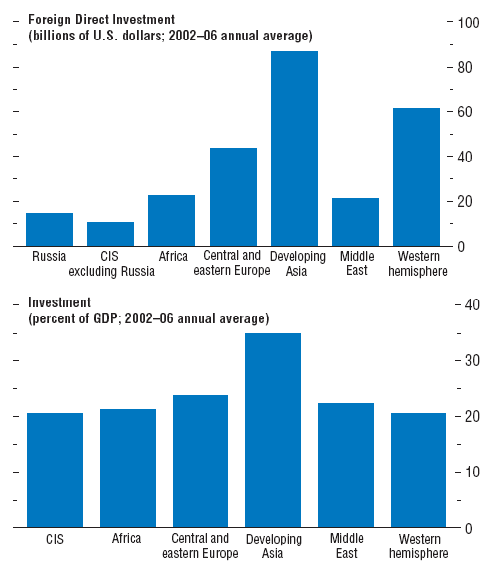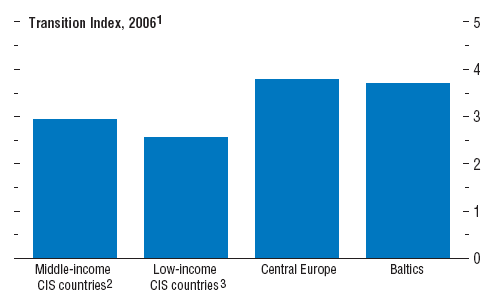|
Commonwealth of Independent States: Strong Growth but More
Economic Diversification Needed
Activity in the Commonwealth of Independent States (CIS) continues to
expand briskly, reflecting the solid performance of energy exporters and a
pickup in activity among energy importers, many of which have benefited from
rising nonfuel commodity prices and strengthened domestic demand (Table
2.6). Looking forward, while real GDP growth is expected to moderate, its
pace would be second only to emerging Asia among the major regions. In
Russia, growth would remain strong, although output appears to be running
close to capacity in the face of robust domestic demand. Oil production
growth has slowed, however, reflecting limited past investment. In Ukraine,
the rise in international steel prices and robust domestic demand are
underpinning a strong growth rebound, but the pace of activity is expected
to moderate in response to large increases in the price of imported natural
gas and an associated overall deterioration in the terms of trade.
Upside risks to the outlook
for the region as a whole relate to a possible rebound in oil prices and
stronger-than-anticipated demand for the region's principal non-oil
commodity exports. On the downside, a sharp slowdown in global activity
could adversely affect exports, although domestic demand should be resilient
in most countries.
Table 2.6. Commonwealth of Independent States: Real GDP, Consumer Prices,
and Current Account Balance
(Annual percent change unless noted otherwise)
|
|
|
Real |
GDP |
|
|
Consumer Prices1 |
|
Current Account Balance2 |
|
|
2005 |
2006 |
2007 |
2008 |
2005 |
2006 |
2007 |
2008 |
2005 |
2006 |
2007 |
2008 |
|
Commonwealth of |
|
|
|
|
|
|
|
|
|
|
|
|
|
Independent States |
6.6 |
7.7 |
7.0 |
6.4 |
12.4 |
9.6 |
9.0 |
8.3 |
8.8 |
7.7 |
5.0 |
4.4 |
|
Russia |
6.4 |
6.7 |
6.4 |
5.9 |
12.7 |
9.7 |
8.1 |
7.5 |
10.9 |
9.8 |
6.2 |
5.0 |
|
Ukraine |
2.7 |
7.1 |
5.0 |
4.6 |
13.5 |
9.0 |
11.3 |
10.0 |
2.9 |
-1.7 |
-4.1 |
-5.5 |
|
Kazakhstan |
9.7 |
10.6 |
9.0 |
8.1 |
7.6 |
8.6 |
8.8 |
6.8 |
-1.3 |
-1.4 |
-0.9 |
-0.4 |
|
Belarus |
9.3 |
9.9 |
5.5 |
3.9 |
10.3 |
7.0 |
11.4 |
13.7 |
1.6 |
-4.1 |
-8.7 |
-6.4 |
|
Turkmenistan |
9.0 |
9.0 |
10.0 |
10.0 |
10.7 |
8.2 |
6.5 |
9.0 |
5.1 |
15.3 |
11.7 |
11.7 |
|
Low-income CIS countries |
12.1 |
14.6 |
14.8 |
12.8 |
12.2 |
11.8 |
12.7 |
11.9 |
2.7 |
7.4 |
11.6 |
17.0 |
|
Armenia |
14.0 |
13.4 |
9.0 |
6.0 |
0.6 |
2.9 |
4.0 |
4.5 |
-3.9 |
-5.0 |
-5.5 |
-5.3 |
|
Azerbaijan |
24.3 |
31.0 |
29.2 |
23.1 |
9.7 |
8.4 |
21.1 |
17.0 |
1.3 |
15.7 |
27.4 |
36.2 |
|
Georgia |
9.6 |
9.0 |
7.5 |
6.5 |
8.3 |
9.2 |
6.3 |
5.5 |
-5.4 |
-9.5 |
-15.2 |
-12.7 |
|
Kyrgyz Republic |
-0.2 |
2.7 |
6.5 |
6.6 |
4.3 |
5.6 |
5.0 |
4.0 |
-2.3 |
-16.8 |
-12.6 |
-10.8 |
|
Moldova |
7.5 |
4.0 |
4.5 |
5.0 |
11.9 |
12.7 |
11.4 |
8.9 |
-8.1 |
-8.3 |
-6.2 |
-5.7 |
|
Tajikistan |
6.7 |
7.0 |
7.5 |
8.0 |
7.3 |
10.1 |
11.4 |
9.2 |
-2.5 |
-2.5 |
-15.2 |
-15.3 |
|
Uzbekistan |
7.0 |
7.2 |
7.7 |
7.5 |
21.0 |
19.5 |
10.4 |
12.2 |
14.3 |
19.4 |
19.7 |
18.6 |
|
Memorandum |
|
|
|
|
|
|
|
|
|
|
|
|
|
Net energy exporters3 |
7.1 |
7.7 |
7.4 |
6.8 |
12.5 |
9.8 |
8.6 |
7.9 |
9.9 |
9.3 |
6.5 |
5.8 |
|
Net energy importers4 |
4.5 |
7.7 |
5.4 |
4.7 |
12.0 |
8.5 |
10.8 |
10.1 |
1.6 |
-3.2 |
-6.0 |
-6.3 |
1ln
accordance with standard practice in the World Economic Outlook,
movements in
consumer prices are indicated as annual averages
rather than as December/December
changes, as is the practice in some countries.
2Percent
of GDP.
3includes
Azerbaijan, Kazakhstan, Russia, Turkmenistan,
and Uzbekistan.
4includes
Armenia, Belarus, Georgia, Kyrgyz Republic, Moldova,
Tajikistan, and Ukraine.
Current account positions have strengthened in energy exporters such as
Turkmenistan and Azerbaijan. In other countries, current account balances
have deteriorated due to a strong rise in import volumes as well as the
rising costs of energy imports (Ukraine and Georgia) and the weakening
demand for specific exports (Armenia). Looking ahead, the regional current
account position is expected to remain strong, reflecting the continued
underlying strength in demand for the region's principal exports.
Reflecting the strength of domestic demand and strong capital inflows,
inflation among CIS countries remains among the highest in the world,
despite some moderation in several countries. In Russia, headline inflation
came down by 2 percentage points during 2006, reflecting lower administered
price increases and some nominal appreciation of the ruble, but at 9 percent
still remained above the official target of 8.5 percent for end-2006.
Bringing inflation down to the 2007 target of 8 percent will depend on
allowing greater nominal appreciation of the ruble and a more restrictive
fiscal stance. In Ukraine, inflation has recently accelerated into double
digits following the pass-through of higher energy import prices. Monetary
policy needs to play a more active role to ensure that the recent spike in
inflation does not feed into higher inflationary expectations. The
authorities' preliminary steps toward an inflation targeting regime are
welcome, but a gradual transition to greater exchange rate flexibility will
be needed to support this framework.
Fiscal balances in several countries have deteriorated as large spending
increases have outpaced the increase in revenues related to higher export
earnings and stronger domestic economic activity. In some others, fiscal
positions have strengthened. In Russia, the primary fiscal balance has
improved as a large proportion of the higher oil revenues has been placed in
the stabilization fund, although spending has also accelerated. In Ukraine,
spending has been held below budgeted levels while revenue growth has been
strong. More generally, in the context of already strong domestic demand,
governments will need to be careful to avoid excessive public spending
increases, particularly in areas that boost consumption—such as on pensions
and wages—and exert upward pressure on inflation. In countries where there
is scope to boost public spending over the medium term, governments should
ensure that expenditures are geared toward generating high-quality growth
that is not linked to the commodity price cycle and are allocated
efficiently in the context of often weak institutional capacity.
More generally, sustaining the recent strong growth momentum will require a
diversification
of the sources of growth away from exports of primary commodities. The
strength of domestic demand in recent years has been driven to a large
extent by consumption, fueled by capital inflows, rapid credit growth, and,
in some countries, increased public sector spending in the form of wages and
pensions. Despite sizable public investment in some countries, focused
mainly in resource extraction industries and related transportation
infrastructure, the overall ratio of investment to GDP among CIS countries
remains relatively low (Figure 2.9). This underscores the need to attract
greater private investment in noncommodity sectors. Foreign direct
investment, in particular, is low in these sectors. Many countries in the
region have a large unfinished structural reform agenda, as seen, for
example, by the region's slower pace of reform relative to central Europe
and the Baltics, and further progress is needed to improve the investment
climate. The main priorities are broadening and deepening domestic financial
markets, reforming civil services and the energy sector, making tax systems
more growth- and investment-friendly, strengthening the protection of
property rights, reducing corruption and state intervention, and
strengthening legal and regulatory systems.
Figure 2.9. Commonwealth of Independent
States (CIS):
Further Reform Needed to Raise Investment Levels
The CIS region attracts relatively low levels of foreign direct investment,
while
overall investment is still dominated by the natural resources sector and
related
transportation infrastructure. Further reform is needed to improve the
investment
climate.


Sources: EBRD, Transition Report; and IMF staff
calculations.
Notes:
1/ The transition Index is the unweighted average of large-scale
privatization index, smallscale
privatization index, enterprise restructuring index, price liberalization
index, trade and
forex system index, competition policy index, banking reform and interest
rate liberalization
index, securities markets and nonbank financial institutions index, and
overall infrastructure
reform index.
2/ Belarus, Kazakhstan, Russia, Turkmenistan, and Ukraine.
3/ Armenia, Azerbaijan, Georgia, Kyrgyz Republic, Moldova, Tajikistan, and
Uzbekistan.
|